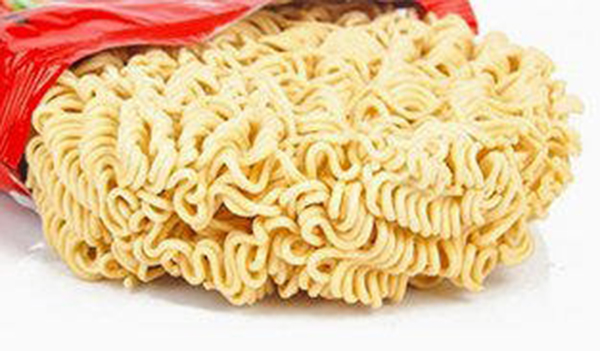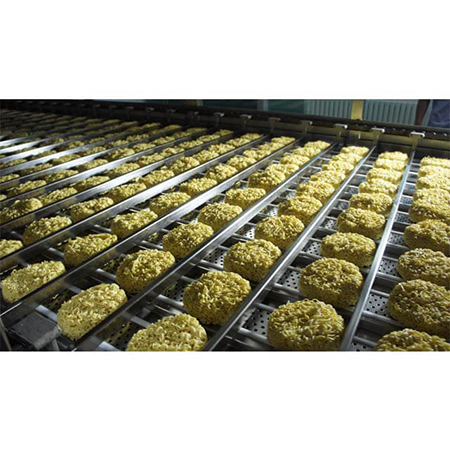© 2017-2018 Shangbaotai Machine Technology (Kunshan) Co., Ltd. All rights reserved. Site Map
You’ve probably had instant noodles when you're too lazy to cook up a warm meal, but do you know how they’re made?
WHY WERE INSTANT NOODLES INVENTED?
A combination of three things led to the invention of instant noodles. First, a starving Japanese population post World War II. Second, the Japanese government’s quest to use up rations of wheat flour and oil supplied by U.S. aid. Lastly, Momofuku Ando, a recently unsuccessful business man, looking to rebuild his life.
Ando was informed by his contacts in the government that they were looking for ways to encourage Japanese people to eat American flour. Viewing this as a business opportunity, he is said to have disappeared into a wooden shed behind his house in Osaka for a whole year. When he emerged in 1958, he had invented “Chikin Ramen”, the first ever instant noodle. The noodles came as dried bricks with separately packed seasoning, not very different from varieties of instant noodles available today.

The next milestone in Momofuku Ando’s career was the invention of cup noodles in 1971. Inspiration is said to have struck him while he was on a field trip to the United States. There, he saw supermarket staff breaking up Chikin Ramen noodles, putting them in a cup, pouring hot water, and then eating them with a fork. He realised that his product could become a ‘global food’ if he reinvented it to suit the eating and cooking habits of working people around the world who did not necessarily have a bowl at hand.
HOW ARE INSTANT NOODLES MADE?
The production process of instant noodles has not changed much since its invention. The ingredients are mixed, the dough is rolled out, cut into noodles, steamed, dried, fried for a minute or two for dehydration, cooled, and then packed into individual units. Some varieties skip the frying step and are dehydrated using hot air.
Instant noodles are often accompanied by sachets containing seasoning. Seasonings can be of three kinds: powder, liquid, and granulated powder. Among these, the powder type is the most common. It may contain a variety of ingredients, right from basic stuff like salt, sugar, soy sauce, and oil to more complex mixes made from dehydrated meat, seafood, fungi, and spices.
A third component of instant noodles is the garnish. Garnishes are more common in the “premium” varieties and play an important role in enhancing the texture and nutrition of the noodles. Technological innovation in the last decades have introduced advanced methods to extend the shelf life of garnishes. Today, they are dried in one of the following ways:
Hot air: Similar to the technique used for dehydrating non-fried noodles. Most garnishes are dried this way.
Vacuum freezing: Ingredients are frozen at -30°C while packed under vacuum. This method helps preserve their nutritional value.Microwave heat: This technique uses machines that heat and dry out garnishes from the inside while maintaining their integrity and texture.
Retort: The garnishes are cooked, filled in pouches, and then sterilized using heat and pressure.

IS IT SAFE TO EAT INSTANT NOODLES?
In 1997, manufacturers around the world came together to establish the World Instant Noodle Association. WINA worked together with the Codex Alimentarius Commission and the World Health Organization to establish quality and safety standards for instant noodles. An international Codex standard was implemented in 2006. It contains information such as which additives can be used and in what quantities and which labeling requirements should be followed.
Instant noodles are cheap, require minimal utilities and time to prepare, and each portion provides between 300 to 500 calories. This makes them an appealing source of nourishment for people with limited resources and time. However, there are some nutrition concerns to take into consideration when eating them on a regular basis. Instant noodles by themselves are an incomplete meal because they lack sufficient quantities of proteins, fibre, vitamins, and minerals.
As it is with any food, moderation is key. The maximum number of instant noodle servings that can be safely consumed by a person would depend on a variety of factors including health status and nutritional needs.
So, in conclusion, it is okay to eat instant noodles once in a while, just don’t forget to supplement them with other nutritious foods like veggies, eggs, and meat.
Shangbaotai Group, with over 40-year experience, is a world’s leading manufacturer for producing noodles processing line, beverage packaging equipments and plastics moulds. If you are interested, contact us freely.